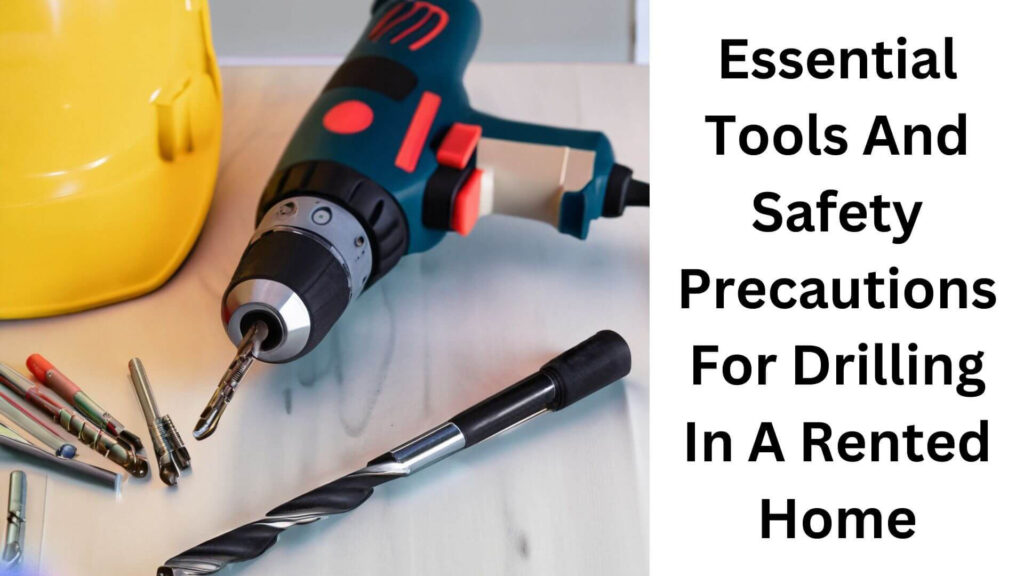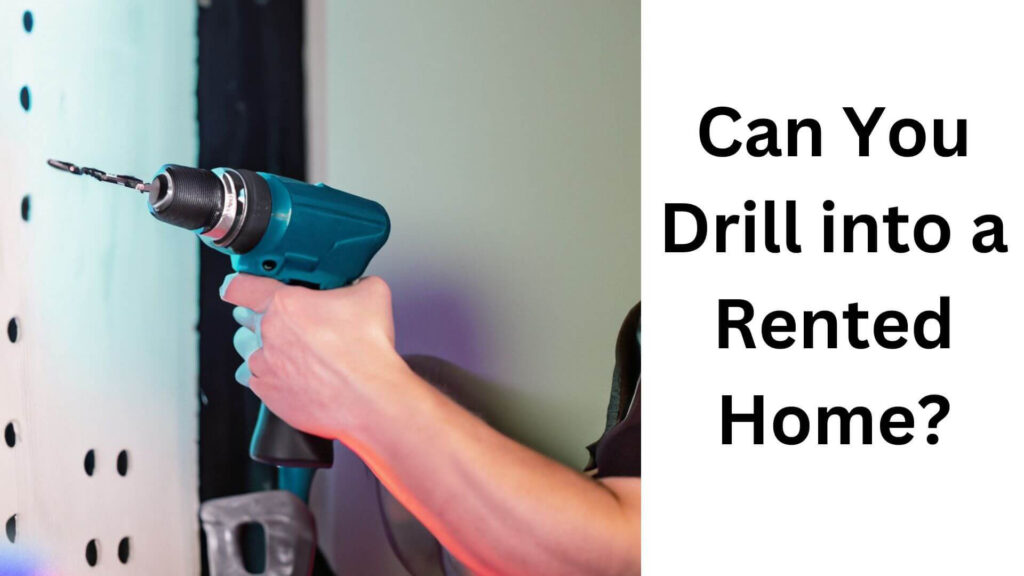Drilling holes into walls or ceilings is a common part of home decorating, but if you’re living in a rented property, the process requires a bit more consideration. Whether you want to hang artwork, mount shelves, or install curtain rods, the decision to drill can have legal and financial consequences, as well as potential impacts on the property’s condition.
In this blog post, i will explore the risks and limitations, legal aspects, tools, safety precautions, and alternative no-drill methods to help you make informed decisions about drilling in a rented home.
Table of Contents
Understanding The Risks And Limitations Of Drilling In A Rented Home
When living in a rented home, the walls and other surfaces are not yours to modify freely. Drilling may leave permanent holes or damage the structure, which could lead to penalties, loss of security deposits, or costly repairs. Here are some risks and limitations you need to consider:
- Security Deposit Risk: The most common concern is losing part or all of your security deposit if you cause damage by drilling. Even small holes may be considered damage if they are not properly patched and painted before moving out.
- Landlord Restrictions: Many landlords include clauses in the lease agreement that prohibit drilling or modifying walls, ceilings, or floors. Violating these terms can lead to penalties, such as fines, additional fees, or even eviction in extreme cases.
- Property Damage: Drilling in the wrong location can cause significant damage. You may accidentally drill into electrical wiring, plumbing, or structural elements, causing safety hazards and requiring expensive repairs.
- Repair Costs: If damage is significant or left unrepaired, you may be liable for the cost of hiring professionals to restore the property to its original condition. This can include patching holes, repainting, or even repairing drywall or masonry.
Key Takeaway: Before drilling into any surface in a rented home, always review your lease agreement, consult your landlord, and consider the risks involved.
Check Also: Discover the Perfect Drill Machine for Home Projects!
Essential Tools And Safety Precautions For Drilling In A Rented Home
If your landlord gives you permission to drill, or if your lease allows it, you’ll want to make sure you have the proper tools and follow safety precautions to prevent damage and protect yourself.

Essential Tools
- Drill: A cordless or electric drill is a must for creating clean, controlled holes. If you’re drilling into masonry or concrete, you may need a hammer drill.
- Appropriate Drill Bits: Choose the right drill bit for the surface you are working with. For example, masonry bits are for brick or concrete, while regular twist bits are for wood or drywall.
- Stud Finder: To avoid drilling into electrical wiring or plumbing, use a stud finder to locate safe spots for drilling.
- Measuring Tape and Pencil: Use these to mark precise drilling points and ensure even spacing for multiple holes.
- Level: Ensure your holes are straight and aligned for shelving or picture frames.
- Screwdriver: A manual or electric screwdriver will help you install screws or anchors once the holes are drilled.
Safety Precautions
- Wear Protective Gear: Always wear safety glasses and a dust mask to protect your eyes and lungs from debris.
- Check for Wiring and Pipes: Use a stud finder with wire and pipe detection features to avoid drilling into live wires or water pipes.
- Start Small: Use a small pilot hole first to ensure you’re in the right spot, then gradually increase the hole size if needed.
- Have Patch Materials on Hand: If you make a mistake or plan to move soon, keep spackling paste, sandpaper, and matching paint available for repairs.
Safety Precautions To Take Before, During, And After Drilling
When drilling in a rented property, it’s crucial to prioritize safety not just for the property but for your own well-being. Here’s a comprehensive list of precautions to take before, during, and after drilling:
Before Drilling
- Review the Lease Agreement: Always check your lease for any clauses that prohibit drilling, or consult your landlord for clarification.
- Locate Studs: Use a stud finder to identify safe spots where drilling won’t cause structural or electrical damage. Avoid areas around outlets and switches.
- Use the Right Tools: Make sure you have the correct drill bits and screws for the surface you are drilling. Using the wrong tools can cause cracking, crumbling, or large, unsightly holes.
During Drilling
- Keep the Area Clear: Remove furniture and decor from the immediate area to prevent damage from dust or falling debris.
- Drill Slowly: Start the drill at a low speed and gradually increase to prevent cracking the surface, especially with delicate materials like plaster or tile.
- Monitor Dust and Debris: Use a dust catcher or vacuum as you drill to minimize mess, especially if you’re working on higher walls or ceilings.
After Drilling
- Inspect the Hole: Ensure the hole is clean and the anchor or screw is securely installed.
- Repair Mistakes Immediately: If you make a mistake, fill the hole with spackle or a wall patch kit right away to prevent the damage from worsening.
Tips For Protecting Your Health And Safety While Drilling In A Rental Property
Drilling can be hazardous if proper safety measures aren’t taken. Here are some health and safety tips to keep in mind:
- Ventilate the Area: Drilling can create dust and debris that may be harmful if inhaled. Open windows or use fans to improve air circulation.
- Use Dust Masks: Protect your lungs from airborne particles by wearing a dust mask.
- Check the Drill’s Condition: Inspect the drill for any frayed cords or loose parts before use, and ensure it is fully charged or plugged in securely.
- Take Breaks: If you’re drilling multiple holes, take frequent breaks to avoid hand fatigue or overheating the drill.
- Use the Right Ladder: If drilling above shoulder height, make sure to use a stable ladder, and always have someone spot you.
Read More: Mastering Brick Wall Drilling: The Ultimate Guide for Homeowners!
Legal Considerations For Drilling Holes In A Rented Home
Before you pick up the drill, it’s important to know the legal implications of drilling in a rented property. Many lease agreements include specific clauses about modifications, and breaking these rules can result in fines, eviction, or loss of your security deposit. Here are key legal factors to keep in mind:
- Lease Agreement: Review the fine print of your rental contract. Some leases outright ban drilling, while others may allow it with prior approval.
- Landlord Consent: Always seek written permission from your landlord if you plan to drill. Even if the lease doesn’t explicitly forbid it, getting approval can protect you from disputes later.
- Local Regulations: Some areas have building codes that renters must adhere to when making modifications, even for minor drilling. Check your local laws or ask your landlord if this applies.
- Responsibility for Repairs: If you cause damage, you could be legally responsible for repairs. Landlords can withhold your security deposit to cover these costs, or worse, take legal action if the damage is severe.
The Benefits Of A No-Drill Approach To Decorating Your Rental Home
Given the potential risks and legal challenges of drilling in a rental home, many renters prefer to opt for no-drill solutions for hanging decorations, curtains, or shelving. Here are some benefits of using these alternatives:
- Avoid Damage: No-drill methods like adhesive hooks, tension rods, or command strips leave no permanent marks, keeping the property in its original condition.
- Easier to Remove: Unlike screws or nails, no-drill solutions can be removed easily without the need for patching or painting.
- Landlord Approval Not Needed: Most no-drill methods are considered temporary, meaning they usually don’t require the landlord’s permission.
- Budget-Friendly: You won’t need to invest in drills, bits, or repair kits, and you won’t have to pay for any damage-related expenses when you move out.
Frequently Asked Questions about Drilling into a Rented Home
1. Can I drill holes into a rented home?
It depends on your lease agreement. Some landlords allow drilling with prior approval, while others prohibit it entirely. Always check your lease and get permission before drilling.
2. What happens if I drill without permission?
If your lease forbids drilling, you could lose your security deposit, face fines, or be held responsible for repairs. In extreme cases, it could even result in eviction.
3. How can I repair holes made by drilling?
To fix small holes, fill them with spackle or wall filler, sand them down until smooth, and repaint to match the wall color.
4. Are there alternatives to drilling for hanging things?
Yes, you can use adhesive hooks, command strips, tension rods, or furniture that doesn’t require wall mounting to avoid drilling holes.
5. Can I drill into tile or masonry in a rental?
Drilling into tile or masonry should be done with extra care and always with landlord permission, as damage to these materials is often harder to repair and more costly.
Final Word
Drilling into a rented home is not a decision to take lightly. While it can offer convenience for hanging items and making your space more functional, the risks of property damage, legal issues, and losing your security deposit are significant. Always review your lease, get landlord approval, and follow proper safety precautions if you choose to drill. Alternatively, no-drill solutions offer a damage-free, landlord-friendly way to decorate and personalize your rental space.

Hey, I am MD Hrithik Hossain, I’m a huge fan of DIY crafts. My workshop is where I spend most of my spare time, and I’m always working on some project. To that end, I’d like to share some of my knowledge and experience with you in power tools, woodworking, and other specialized materials fabrication.
I will guide you with genuine knowledge that can assist you with deciding whether a drill is appropriate according to your requirements or not. If you want to find the best drill and know which type of drill is most suited for your needs, then I can guide you with my expertise. My passion lies in helping others find the correct products they need at an affordable price.


